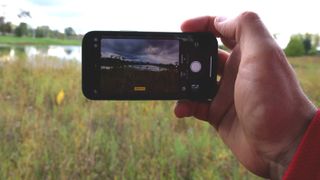What Is iPhone 13’s “Cinematic Mode” and How Does It Work?
Enjoy your iPhone 13’s camera to the max with its innovative “Cinematic Mode.”

Apple’s iPhone 13 is one of the most-awaited smartphone releases this year. As the 13th iteration of the world’s best-selling smartphone series, we can expect a few new jaw-dropping features each year, and this year is no exception. One of the features we’re most excited about is its Cinematic Mode.
In September, Apple introduced a loyal fanbase to the all-new iPhone 13. While we’re really past the point of groundbreaking new features -- and could arguably switch to a multiyear development cycle -- there’s really a lot to like for a phone starting at $699. If presales are any indication, this will be a popular model.
Most Notable Features of the iPhone 13
For videography and photography junkies, one of iPhones 13’s most attractive offers is its new Cinematic Mode. But that’s not all you can expect with this year’s release.

- Brighter screen - Apple’s latest flagship phone features a Super Retina XDR display that is said to be 28 percent brighter.
- Upgraded design - The iPhone 13 features a slightly altered design, including a slightly smaller camera notch and an ever-so-slightly thicker body.
- Powerful new processor - The new phone will include a 6-core CPU consisting of two performance cores and four efficiency cores. It will also have a 4-core GPU and a 16-core neural engine that allows its own neural network and machine learning algorithms to run without using the central processing unit or the graphics processing unit.
- New diagonal dual-lens rear camera - unlike iPhone 12’s vertical camera, iPhone 13 will sport a diagonal design instead. The new camera will also offer an improved aperture that lets in up to 47 percent more light.
- Longer Battery Life - The iPhone’s thicker body exists to carry a larger battery. This, according to Apple, will improve battery life by as much as two-and-a-half hours over the previous model.
What Is iPhone’s Cinematic Mode?
Without further adieu, let’s get to a feature any iPhone video enthusiast should be excited about. Apple, each year, boasts one of the most capable cameras available in a smartphone, and the iPhone 13 is no exception.
Inside the camera app you’ll find Cinematic Mode, a sort of video version of Portrait Mode. You’ll find a number of options that allow you to change focus, as well as play with foreground and background options, applying depth-of-field effects for crisp imagery, or a soft, blurred bokeh effect. Better still, you can adjust all of these options after shooting the video. Whether you’re recording your kids on the playground or a cinematic, sweeping panorama of the scenery on your next vacation, Cinematic Mode offers flexibility in how you want to capture your next shot.

And while some of these features could be cobbled together using a variety of third-party apps in previous years, it’s certainly nice to bring the additional options to the primary camera application. Simplicity aside, another benefit of Cinematic Mode over using other apps to gain this kind of functionality is that it runs on the neural engine inside the A15 Bionic Chip. Third-party applications won’t have access to the neural engine, which could lead to slower performance in machine learning-heavy applications like this.
As with all iPhone releases, there has been commentary both raving and ranting about the new feature. Some call it a quantum leap in terms of smartphone photography, while others have called it ineffective and downright useless. For me, I’d expect a great beginning to what will be iterated on for generations to come. I don’t expect perfection. Portrait Mode, when first launched, was gimmicky and arguably useless. Ditto Apple Maps. But Apple, as Apple always does (with software, anyway) will eventually get it right. And that’s what I’m excited about.
Stay in the know with Laptop Mag
Get our in-depth reviews, helpful tips, great deals, and the biggest news stories delivered to your inbox.
How Does iPhone 13’s Cinematic Mode Work
iPhone’s Cinematic Mode works by tracking multiple points on your subject, allowing it to track more than one point of focus. This lets you seamlessly switch between different people, or elements, in the video. Using the iPhone’s ultrawide lenses help track movement and leads to picture perfect captures of entries and exits from the frame, shifting focus as needed to spotlight these changes.

Another benefit is that your iPhone will save this information in real-time. This means if you change your mind later and want to shift the focus to a new subject in the video, you still have that option.
How to Use the Cinematic Mode
Unlike an expensive DSLR, Cinematic Mode is a breeze to use. After opening your camera app swipe to the right until you switch to Cinematic Mode. Align your camera in such a way that your main subject is within the shot. Click your subject to help your iPhone focus on it.
From there, just click on the shutter button to begin recording. You will notice that once another subject enters the view, the camera will also focus on them. After you’ve taken your video, press the shutter button again to stop recording.
There you have it. You are now ready to create a cinematic masterpiece using just your iPhone.
